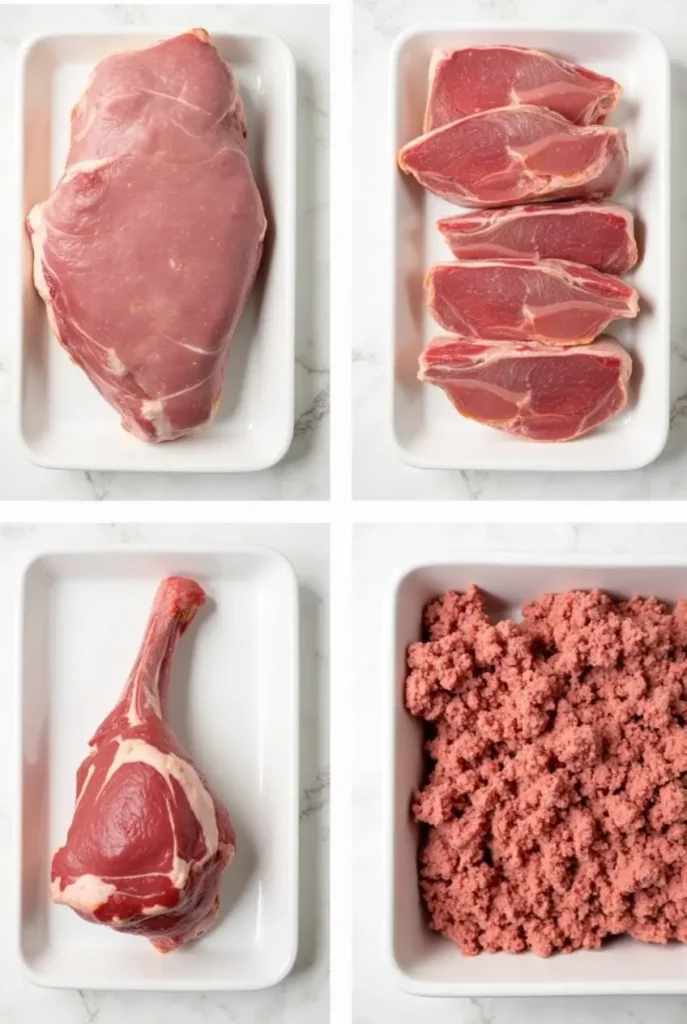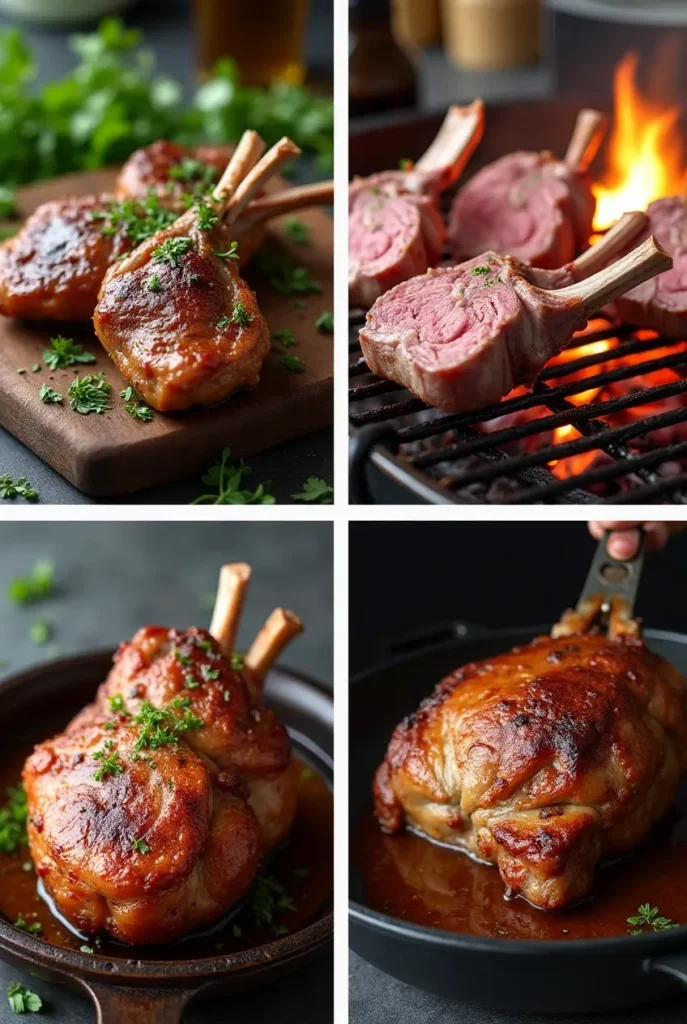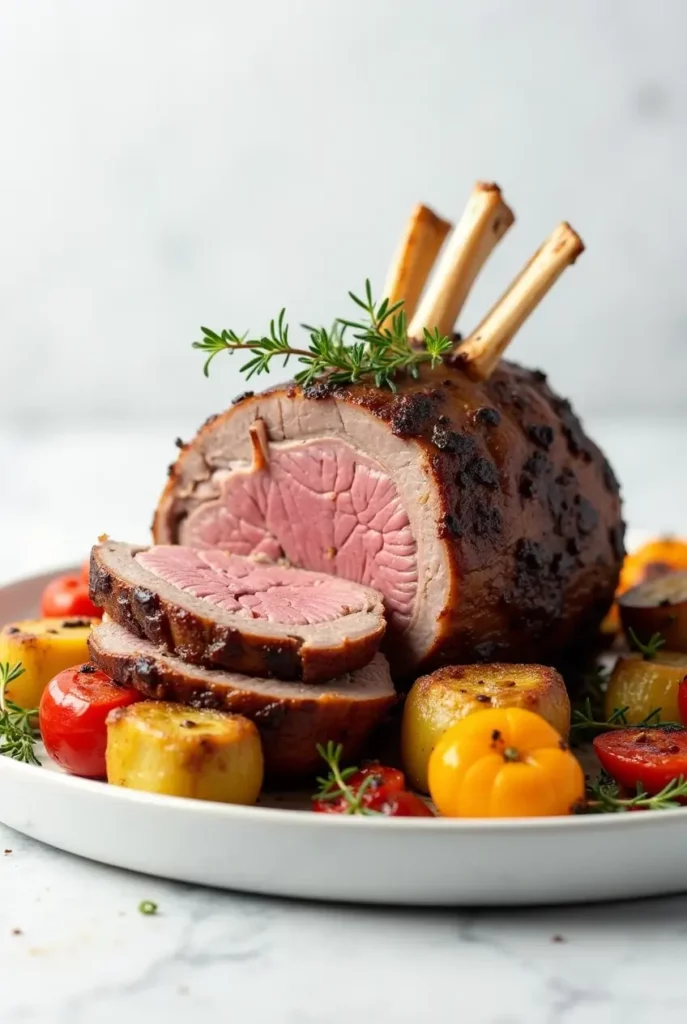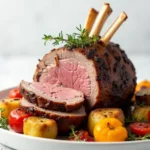Introduction
Few meats offer the rich flavor, tender texture, and versatility of fresh lamb. Whether slow-cooked, grilled, or roasted, lamb meat is a favorite in many cuisines around the world. But not all lamb is the same—different cuts, sources, and cooking methods can significantly impact its taste and quality.
In this guide, we’ll dive deep into everything you need to know about fresh lamb. From selecting the best cuts to understanding grass-fed vs. grain-fed lamb, we’ll explore what makes fresh lamb a delicious and nutritious choice. We’ll also discuss the sustainability of lamb farming and share expert cooking tips to help you prepare mouthwatering lamb dishes.
If you’re a home cook, food enthusiast, or simply someone who loves a good lamb dish, this article is for you!
Table of Contents
What is Fresh Lamb?
Lamb is the meat of young sheep, typically under 12 months old, which gives it a milder flavor and more tender texture compared to older sheep (mutton). But what exactly defines fresh lamb?
Understanding Fresh Lamb vs. Frozen Lamb
When buying lamb meat, you’ll often see fresh and frozen options. But is one better than the other?
- Fresh lamb is sold without being frozen, meaning it retains its natural texture and moisture. This results in a juicier, more flavorful bite.
- Frozen lamb, while convenient, may lose some natural tenderness when thawed improperly. However, when frozen correctly, it can still offer great taste and quality.
If you’re aiming for optimal flavor and texture, fresh lamb is always the top choice.
Nutritional Value and Health Benefits of Fresh Lamb
Aside from being delicious, fresh lamb is also packed with essential nutrients. Here’s why it’s a healthy choice:
- High in Protein – A great source of lean protein, perfect for muscle building and recovery.
- Rich in Iron – Helps prevent anemia and supports oxygen circulation in the body.
- Loaded with B Vitamins – Especially B12, which is essential for brain function and energy.
- Contains Omega-3 Fatty Acids – While less than fish, grass-fed lamb has beneficial healthy fats that promote heart health.
How Lamb Differs from Other Meats
Compared to beef, chicken, or pork, fresh lamb has a distinct taste and nutritional profile.
- More Tender Than Beef – Lamb meat has a softer texture due to its lower connective tissue content.
- Less Fatty Than Pork – While still flavorful, lamb tends to have leaner cuts with healthy fats.
- More Nutrient-Dense Than Chicken – Lamb contains more iron, zinc, and B vitamins compared to poultry.
With its unique taste, impressive nutrition, and endless cooking possibilities, fresh lamb is a fantastic choice for any meal.
Popular Lamb Cuts and Their Best Uses

When cooking fresh lamb, choosing the right cut makes all the difference. Some cuts are tender and quick to cook, while others need slow roasting or braising to bring out their best flavor. Here’s a breakdown of the most popular lamb cuts and their ideal uses.
Lamb Shoulder: Best for Slow Cooking
Lamb shoulder is a flavor-packed cut that contains a good amount of fat and connective tissue. This makes it perfect for:
- Slow roasting – Cooking at a low temperature for hours breaks down the fibers, making the meat fork-tender.
- Braised dishes – Shoulder works well in stews and curries, absorbing rich flavors as it cooks.
Since this cut is more affordable than others, it’s a budget-friendly option for making hearty meals.
Lamb Racks & Chops: The Perfect Grilled Option
If you’re looking for something quick and elegant, lamb racks and chops are the way to go. These cuts come from the rib section and have tender, juicy meat with a delicate texture.
- Lamb chops – Ideal for grilling or pan-searing with simple seasoning.
- Rack of lamb – Best roasted whole with a crust of herbs and garlic.
Lamb chops are perfect for a weeknight dinner, while a rack of lamb makes a stunning centerpiece for a special occasion.
Leg of Lamb: Ideal for Roasting
One of the most popular cuts, leg of lamb is lean, flavorful, and easy to carve. It’s perfect for:
- Traditional roasts – Cooked with garlic, rosemary, and olive oil.
- Butterflied and grilled – A faster-cooking method that enhances flavor.
Because it’s naturally tender, leg of lamb doesn’t need slow cooking. Simply roast it at high heat for a crispy outer crust and juicy interior.
Ground Lamb: A Versatile Choice for Many Dishes
Ground lamb is widely used in Mediterranean and Middle Eastern cuisine. It’s a great alternative to beef for:
- Lamb burgers – Juicy and flavorful, especially with spices like cumin and paprika.
- Kebabs and meatballs – Perfectly seasoned and grilled.
- Shepherd’s pie – A comforting dish with mashed potatoes and gravy.
Ground lamb absorbs flavors well, making it a versatile choice for home-cooked meals.
Lesser-Known Cuts: Neck, Flank, and Offal
For those who love slow-cooked, rich dishes, these cuts are worth trying:
- Lamb neck – Great for braising, creating a fall-off-the-bone texture.
- Lamb flank – A budget-friendly cut, best slow-cooked or ground.
- Lamb offal (liver, kidneys, heart) – Packed with nutrients and used in traditional dishes worldwide.
Each cut has its unique flavor and cooking method, making fresh lamb one of the most diverse meats to work with.
How to Select High-Quality Fresh Lamb
Buying fresh lamb is more than just picking up a package at the store. To get the best flavor and texture, it’s important to know what to look for when choosing your meat.
Signs of Freshness: What to Look for at the Butcher
When buying fresh lamb, pay attention to the color, texture, and smell:
- Color – Fresh lamb should be light pink to deep red, with a slight moist sheen. Avoid any meat that looks gray or dry.
- Texture – The meat should feel firm yet slightly springy. If it’s too soft or slimy, it’s not fresh.
- Fat Content – Good-quality lamb has white or creamy fat, not yellowish fat, which can indicate age.
- Smell – Fresh lamb has a mild, slightly grassy scent. A strong or sour smell means it’s past its prime.
Grass-Fed vs. Grain-Fed Lamb: Key Differences
There’s a lot of debate about whether grass-fed or grain-fed lamb is better. Here’s a quick breakdown:
- Grass-fed lamb – Raised on natural pasture, it has a richer, slightly gamey flavor and higher omega-3 content.
- Grain-fed lamb – Fed a diet that includes grains, giving it a milder, slightly sweeter taste with more marbling.
Both options are delicious, so it comes down to personal preference. If you prefer leaner, more natural-tasting meat, go for grass-fed lamb.
Best Places to Buy Fresh Lamb: Butcher, Market, or Online?
Where you buy fresh lamb can affect its quality. Here are your best options:
- Local butcher – The best place for high-quality, customized cuts. You can also ask for cooking tips!
- Farmers’ markets – Great for grass-fed, organic lamb from local farmers.
- Online meat suppliers – Many specialty stores deliver fresh lamb straight to your door. Just ensure they have good reviews and sustainable sourcing.
Choosing fresh lamb from a trusted source ensures better taste, texture, and cooking results.
Cooking Fresh Lamb: Best Techniques & Recipes

Cooking fresh lamb the right way enhances its natural flavor and tenderness. Whether you’re roasting, grilling, or braising, choosing the best cooking method for each cut ensures perfect results every time.
How to Prepare and Marinate Lamb for Maximum Flavor
Before cooking, preparing your fresh lamb correctly is key:
- Trim excess fat – Lamb fat has a strong flavor, so remove any excess fat for a milder taste.
- Bring to room temperature – Let the meat sit out for 30 minutes before cooking for even cooking.
- Marinate for extra flavor – Lamb absorbs marinades well, especially with garlic, rosemary, lemon juice, and olive oil.
A good marinade not only adds flavor but also tenderizes the meat, making it even juicier.
Cooking Temperatures and Doneness Guide
Lamb is best enjoyed at different levels of doneness, depending on the cut and your preference:
- Rare (120-130°F / 49-54°C) – Cool red center, very soft texture.
- Medium-rare (130-135°F / 54-57°C) – Warm red center, tender and juicy.
- Medium (135-145°F / 57-63°C) – Slightly pink center, firmer texture.
- Well-done (160°F+ / 71°C+) – Fully cooked, firm but still flavorful.
For lean cuts like rack of lamb or loin chops, medium-rare is ideal. Tougher cuts, such as shoulder or shank, need low and slow cooking to break down the fibers.
Best Seasonings and Marinades for Lamb
Lamb pairs well with bold flavors that balance its richness. Some of the best seasonings and marinades include:
- Garlic and rosemary – A classic pairing that enhances lamb’s earthy taste.
- Mediterranean herbs – Thyme, oregano, and mint add a fragrant aroma.
- Middle Eastern spices – Cumin, coriander, and sumac bring a warm, smoky depth.
- Yogurt-based marinades – Help tenderize the meat while adding a subtle tanginess.
Top Recipes: From Grilled Lamb Chops to Slow-Cooked Lamb Stew
Once you’ve chosen your cut and seasoning, try one of these delicious recipes:
- Grilled Lamb Chops – Perfectly seared chops, flavored with garlic, lemon, and fresh herbs.
- Slow-Cooked Lamb Shank – Braised in red wine and tomatoes for fall-apart tenderness.
- Spiced Lamb Kebabs – Ground lamb seasoned with cumin, paprika, and coriander, then grilled on skewers.
- Lamb Stew – A hearty dish with vegetables, stock, and warming spices.
Cooking fresh lamb is all about patience and technique. With the right method, you’ll unlock its full potential in every bite!
Comparing Fresh Lamb from Different Regions

Not all fresh lamb tastes the same! Depending on where it’s raised, lamb can have different textures, flavors, and fat content. Here’s how lamb from different regions compares.
American Lamb vs. Australian & New Zealand Lamb
Lamb from America, Australia, and New Zealand are among the most popular worldwide. But how do they differ?
- American lamb – Larger in size, mild and slightly sweet flavor, higher fat content.
- Australian lamb – Leaner, slightly gamey, often grass-fed, making it healthier.
- New Zealand lamb – Smaller, very tender, with a stronger, more distinct lamb flavor.
If you prefer mild and juicy meat, go for American lamb. But if you enjoy leaner, more flavorful cuts, Australian and New Zealand lamb are excellent choices.
Why European Lamb is Considered High-Quality
Europe is known for its premium lamb, especially from France, the UK, and Ireland.
- French lamb (Agneau de Pré-Salé) – Often grazes near coastal salt marshes, giving the meat a delicate, slightly salty flavor.
- Welsh & Scottish lamb – Grass-fed in lush pastures, resulting in tender meat with a natural sweetness.
- Irish lamb – Has a rich, deep flavor due to the mild, rainy climate and high-quality grass diet.
European lamb is often prized for its texture and taste, making it a top choice for fine dining.
What Makes Middle Eastern & Mediterranean Lamb Unique?
Lamb is a staple in Middle Eastern and Mediterranean cuisine, known for its bold flavors.
- Greek lamb – Often cooked on the grill with garlic, lemon, and oregano.
- Middle Eastern lamb – Spiced with cumin, cinnamon, and sumac, then slow-roasted or used in kebabs.
- Turkish lamb – Common in doner kebabs and stews, heavily seasoned and grilled over charcoal.
If you love spiced, slow-cooked meats, Middle Eastern lamb dishes are a must-try.
Sustainable Lamb Farming & Ethical Consumption
Sustainability in lamb farming is more important than ever. Consumers are increasingly looking for eco-friendly and ethical options when purchasing fresh lamb. Choosing responsibly sourced lamb helps support animal welfare, small farmers, and environmental conservation.
The Impact of Lamb Farming on the Environment
Lamb farming, like any livestock production, impacts the environment. However, sustainable practices can reduce its footprint. Some concerns include:
- Greenhouse gas emissions – Sheep farming produces methane, contributing to climate change.
- Land and water usage – Large-scale farms require significant resources, affecting biodiversity.
- Overgrazing – Poor grazing management can lead to soil erosion and habitat loss.
Fortunately, grass-fed, pasture-raised lamb is often more sustainable, as it promotes natural grazing and reduces reliance on processed feed.
Why Choose Organic or Free-Range Lamb?
Opting for organic or free-range fresh lamb benefits both consumers and the environment. Here’s why:
- No synthetic hormones or antibiotics – Organic lamb is raised without chemicals, making it a healthier choice.
- Higher welfare standards – Free-range lambs have better living conditions, leading to better-quality meat.
- Better for the environment – Regenerative farming practices help restore soil health and biodiversity.
Look for certifications like Certified Organic, Animal Welfare Approved, or Pasture for Life to ensure your fresh lamb is ethically sourced.
How to Support Ethical & Sustainable Meat Suppliers
Making conscious buying decisions helps promote sustainable farming. Here’s how you can support responsible lamb production:
- Buy local – Supporting small farms reduces carbon footprints and ensures fresher meat.
- Check farm sourcing – Research where your lamb comes from and look for sustainability commitments.
- Reduce food waste – Use every part of the lamb, from bones for broth to offal for nutrient-rich meals.
By choosing ethically sourced fresh lamb, you contribute to a healthier planet and better farming practices.
FAQs About Fresh Lamb
If you’re new to cooking or buying fresh lamb, you probably have a few questions. Here are answers to some of the most frequently asked questions to help you make the best choices.
How Do You Know If Fresh Lamb Is High Quality?
To ensure you’re getting the best fresh lamb, check for:
Color – It should be light pink to deep red. Avoid gray or dull-looking meat.
Fat – Look for white or creamy fat; yellowish fat can indicate age.
Texture – The meat should feel firm yet slightly springy, not mushy or slimy.
Smell – A mild, fresh scent is ideal; strong odors suggest spoilage.
What Is the Best Way to Cook Fresh Lamb?
Different cuts require different cooking methods:
Lamb chops and racks – Best grilled or pan-seared for a crisp, flavorful crust.
Leg of lamb – Ideal for roasting at high heat to retain moisture.
Shoulder and shank – Need slow cooking (braising or roasting) to become tender.
Ground lamb – Great for burgers, kebabs, and meatballs.
Is Fresh Lamb Healthier Than Other Meats?
Yes! Fresh lamb is packed with protein, iron, and essential vitamins. Compared to beef, it has:
More omega-3 fatty acids, especially in grass-fed lamb.
Higher zinc and B12 levels, which support immune health and energy production.
Less saturated fat in lean cuts like leg and loin.
Can Fresh Lamb Be Frozen Without Losing Quality?
Absolutely! To maintain the best texture and flavor:
Wrap tightly in plastic wrap or vacuum-seal.
Freeze at 0°F (-18°C) for up to 6 months.
Thaw in the refrigerator overnight before cooking.

Fresh Lamb: Cuts, Benefits, Cooking Tips & Sustainability
- Total Time: Up to 3.5 hours
- Yield: 4 servings 1x
- Diet: Low Fat
Description
This guide covers everything you need to know about fresh lamb—from selecting the best cuts to cooking tips, sustainability, and nutritional benefits. Learn how to prepare and cook lamb to perfection for any meal.
Ingredients
- 2 lbs fresh lamb (shoulder, rack, or leg, depending on the recipe)
- 2 tbsp olive oil
- 4 cloves garlic, minced
- 1 tbsp fresh rosemary, chopped
- 1 tbsp fresh thyme, chopped
- 1 tsp ground cumin
- 1 tsp paprika
- Salt and black pepper to taste
- Juice of 1 lemon
- 1/2 cup red wine or broth (for slow-cooked dishes)
Instructions
- Trim excess fat from the lamb to reduce any strong flavors.
- Marinate the lamb with olive oil, garlic, rosemary, thyme, cumin, paprika, salt, and lemon juice. Let it sit for at least 30 minutes for enhanced flavor.
- Preheat the oven or grill. For roasting, set the oven to 375°F (190°C). For grilling, heat to medium-high.
- Cook the lamb according to its cut:
- Shoulder & Leg → Slow roast for 2-3 hours at 325°F (163°C).
- Lamb Chops & Racks → Grill or pan-sear for 3-4 minutes per side.
- Rest the lamb for 10-15 minutes before slicing and serving to retain its juices.
Notes
- For extra tenderness, marinate overnight.
- Pair with roasted vegetables, mashed potatoes, or a fresh salad.
- Use a meat thermometer for accuracy: 130°F for medium-rare, 145°F for medium, 160°F for well-done.
- Prep Time: 30 minutes
- Cook Time: Varies (30 minutes to 3 hours)
- Category: Dinner
- Method: Roasting, Grilling, Braising
- Cuisine: Global
Nutrition
- Calories: 350 kcal
- Fat: 20 g
- Saturated Fat: 8 g
- Carbohydrates: 5 g
- Fiber: 1 g
- Protein: 40 g
- Cholesterol: 85 mg
Keywords: fresh lamb, lamb cuts, grass-fed lamb, lamb recipes, lamb cooking tips, lamb sustainability

